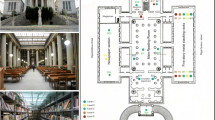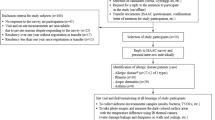Abstract
Houses that underwent water damages are often responsible for heath problems of the occupants. Since there is no universally used protocol for the analysis, we wanted to verify the usefulness of surface sampling versus air sampling for the evaluation of mold diversity in problematic houses and the value of the number of visible mold growth zones to predict air quality. Seventeen houses were sampled for culturable molds in the air and on the surfaces showing contamination. We compared the mold taxa found in the air and on the surfaces and verified the correlation between the number of moldy surfaces and airbone mold concentration. This study demonstrated that, surprisingly, some of the so called wet spore molds (e.g. Stachybotrys) were found more often from air than surface samples whereas, some dry spore molds (e.g. Asp. fumigatus) was more easily isolated from surface samples. There was a good correlation between the number of visible mold growth zones and the concentration of airborne molds. We conclude that air and surface sampling are necessary to evaluate mold diversity in problematic houses and that the number of mold growth zones is a good predictor of airborne mold concentration.
Similar content being viewed by others
References
Beguin H. and Nolard N.: 1994, Moulds biodiversity in homes I. Air and surface analysis of 130 dwellings, Aerobiologia 10, 157–166.
Burge H.A.: 1990, Bioaerosols: prevalence and health effects in the indoor environment. Journal of Allergy and Clinical Immunology 86, 687–701.
Burge H.A.: 1995, Aerobiology of the indoor environment. Occup Med 10, 27–40.
Cooley J.D., Wong W.C., Jumper C.A. and Strauss D.C.: 1998, Correlation between the prevalence of certain fungi and sick building syndrome. Occup. Environ. Med. 55, 579–584.
De Koster J.A. and Thorne P.S.: 1995, Bioaerosol concentrations in noncomplaint, complaint and intervention homes in the midwest. Am. Ind. Hyg. Assoc. J. 56, 573–580.
Icenjour C.R. and Levetin E.: 1997, Penicillium and Aspergillus species in the habitats of allergy patients in the Tulsa. Oklahoma area, Aerobiologia 13, 161–166.
Macher J.M. and Huang F-Y.: 1991, A two year study of microbiological indoor air quality in a new appartment. Arch. Environ. Health 46, 25–29.
McGrath J.J., Wong W.C., Cooley J.D. and Strauss D.C.: 1999, Continually measured fungal profiles in sick building syndrome. Curr. Microbiol 38, 33–36.
Miller J.D., Laflamme A.M., Sobol Y., Lafontaine P. and Greenhalgh R.: 1988, Fungi and fungal products in some Canadian houses. Int. Biodeter. 24, 102–120.
Raper K.B., Fennell D.I. and Austwick P.K.: 1965, The genus Aspergillus. Williams and Wilkins, Baltimore.
Samson R.A., Hoekstra E.S., Frisvad J.C. and Filtenborg O.: 1996, Introduction to Food-borne Fungi. Centraalbureau Voor Schimmelcultures, The Netherlands.
St-Germain G. and Summerbell R.: 1996, Champignons Filamenteux d'intérêt médical. Star Publishing Company, Belmont.
Wang C.J.K. and Zabel R.A.: 1990, Identification Manual for Fungi from Utility Poles in the Eastern United States. American Type Culture Collection, Lawrence.
Watabene T.: 1994, Pictorial Atlas of Soil and Seed Fungi. CRC press Inc., Boca Raton.
Author information
Authors and Affiliations
Rights and permissions
About this article
Cite this article
Duchaine, C., Mériaux, A. The importance of combining air sampling and surface analysis when studying problematic houses for mold biodiversity determination. Aerobiologia 17, 121–125 (2001). https://doi.org/10.1023/A:1010872732534
Issue Date:
DOI: https://doi.org/10.1023/A:1010872732534




